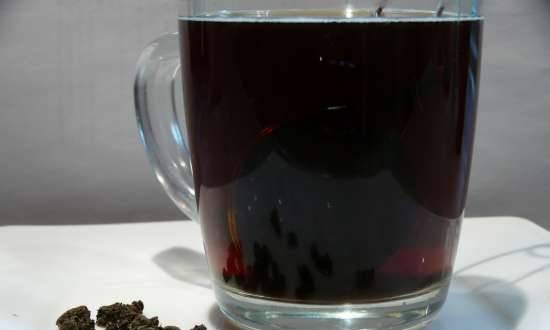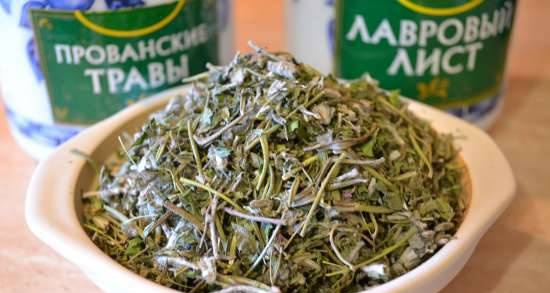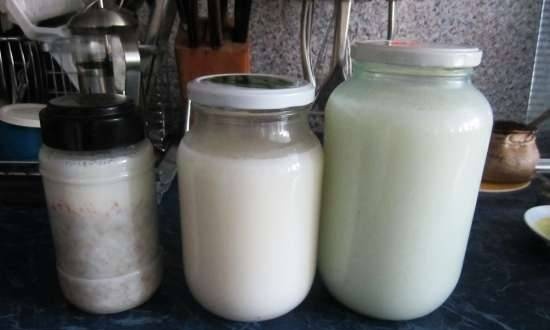|
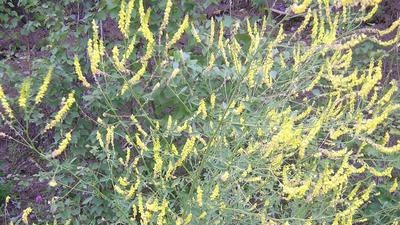 Stern! For tetrapods, they should also be varied, like our food. The ideal for collecting them is a natural meadow. It contains fifty different types of herbs, or even more. Stern! For tetrapods, they should also be varied, like our food. The ideal for collecting them is a natural meadow. It contains fifty different types of herbs, or even more.
The glory of Vologda butter began not in a sown field, but in a wild Vologda meadow. Siberian oil "White Swan" also came from wild meadows, Siberian expanses of Baraba. But what can you do, the world is small. It is necessary to allocate space for buildings, roads, and arable land. The wild meadow is wonderful, but the sown gives more mass from every square meter. You have to sow. Instead of fifty herbs, one. Or several. But not ten or fifty.
What are we sowing? The main thing is cereals: timothy, fescue, hedgehog; their eternal companions are legumes: alfalfa, clover, sainfoin. Sedges are still listed in the category of the worst grasses, and no one sows them.
We still have herbs. There are many beautifully flowering herbs. And experts believe that beautiful flowers are a sign of a bad meadow. Nevertheless, there are many ugly herbs among the herbs, very useful, although, perhaps, poorly nutritious or not at all nutritious. Cumin, nettle, yarrow and especially wormwood. To this day, nettles are considered "hot feed" for livestock, and although they do not sow it on purpose, they should. True, there is still enough of the one that grows in the backyards. We are not sowing wormwood either, although we already have experience. Sheep health is based on wormwood. Returning from the best pastures, sheep who have grown fat should graze for a week on a meager wormwood diet. For prevention. Such sheep are not afraid of any wintering later.
However, food is not only about herbs. These include broad beans, beets, cabbage, and fodder pumpkin.
Sweet clover grass is tempting in that it can be used to solve three problems at once: to get honey, improve the soil, and even have green fodder in addition. From the beginning of summer until the end, there is one more plus for the sweet clover: it is not afraid of drought. When everything around burns out, the sweet clover is still green. Moreover, it gives honey. Even I. Bunin noticed this and commented:
Brother, in dusty boots,
Threw a flower growing in pairs on my windowsill,
Drought flower - yellow sweet clover.
I got up from the books and went to the steppe ...
Well, yes, the whole field is golden,
And from everywhere the points of bees Float in the dry evening heat ...
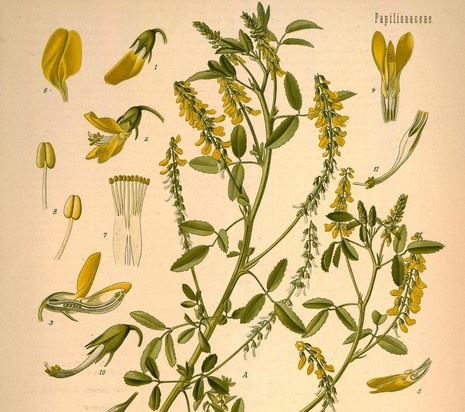 The bees really swim to the melilot in such masses as on any other grass. And in the morning. And in the afternoon. And in the evening. And especially in the heat. When the heat comes, the bees throw the buckwheat: its nectar thickens and dries. Sweet clover is fresh in any dry state. Not diluted even in bad weather. It happens that a beekeeper sows a special honey herb phacelia near the hives. In a drought, bees and phacelia do not sit down. They fly to look for sweet clover. The bees really swim to the melilot in such masses as on any other grass. And in the morning. And in the afternoon. And in the evening. And especially in the heat. When the heat comes, the bees throw the buckwheat: its nectar thickens and dries. Sweet clover is fresh in any dry state. Not diluted even in bad weather. It happens that a beekeeper sows a special honey herb phacelia near the hives. In a drought, bees and phacelia do not sit down. They fly to look for sweet clover.
Melilot flowers are so attractive to bees that this even results in a loss. When they begin to mow the sweet clover with a combine, the bees die in masses. The rumbling machine, perhaps, scares them, but they cannot tear themselves away from the nectar. After all, it contains almost half of glucose and the same amount of fructose!
To save the honey collectors, the Zhytomyr combine operators installed a special device. Two beams are fastened in front, like stems on a sailboat. A wire is pulled between them parallel to the cutting part. The wire shakes the bees off the grass before the knives touch it.
Insidious grass and cows are no less tempting, although agronomists have different opinions on this issue. The best connoisseur of sweet clover, agronomist N. Artyukov, once argued with another fan of sweet clover, N. Salamatin. “Your cows do not eat sweet clover because you don’t sow it,” said Salamatin. “We are sowing. Ours eat. "
Artyukov objected: "In the meadow, they walk around it for three miles!"
Salamatin nodded in agreement: they walk around until they got used to it. And it is worth feeding the sweet clover for two or three days, then you can't drag it by the ears.
To make this conversation more understandable, let me explain: the cows' initial aversion to honey grass depends on the odorous substance coumarin, which fishermen use as bait for fish. Fish like coumarin, cows don't at first.
Rub the sweet clover leaf with your fingers - immediately feel the pungent smell. Melilot can be recognized even in the dark, even with closed eyes. Burenki, of course, will also recognize him. But three days pass - and they get used to it. And then, on the contrary, they begin to demand sweet clover. The more it is in the grass, the better they eat.
At a state farm near Rossosh, a scientific institute conducted an experiment: it was decided to check how much sweet clover dairy cows like. Let them go to the pasture. The first day did not bring joy. The cows greeted the unfamiliar food warily. They ate sluggishly. The next day, milk yield dropped. The shepherds who served the herds became worried. However, the experience had to be completed. An experimental herd of 100 heads was selected, which was put on the sweet clover. Another hundred cows were left in an ordinary forb meadow. For a day or two the competition went in favor of forbs. Three days later, the milk yield of cows that ate sweet clover sharply increased. The milk yield curve briskly crept up. And the control herd was still producing the standard milk rate.
The scientists were preparing to celebrate the victory, when suddenly a week later a milk river from the control herd began to flow just as violently. Burenki, devouring forbs, quickly caught up with their rivals. Milk yield is equal. The glory of the clover was shaken again. Researchers did not expect such a turn of the case. At first they were even confused, not knowing how to explain the situation. And no one would have guessed what was the matter if not for the local buster. Returning from work at night, he found shepherds who were driving control cows to ... sweet clover! They secretly grazed them all night on the honey grass, and in the morning they returned them to their usual pasture. The experience was ruined. However, everyone was satisfied. Both scientists and shepherds. We made sure that the sweet clover makes the rivers of milk full-flowing.
And yet, some milk scientists were afraid that the new-found herb would spoil the taste of milk and butter. One day an inspector comes to one of the large state farms. I learned that the cows were transferred to sweet clover. I tried the oil and said: "The oil is excellent, but there is an unpleasant aftertaste, it smells of coumarin ..."
They called the zootechnician and asked: "What were the cows fed with?" - “Normal hay. We will turn on the sweet clover from tomorrow. "
It just seemed to the specialist ... Then they checked both milk and butter more than once. Neither color nor taste changed.
But the oil was stored longer - phytoncides of honey grass played a role. As for the aroma, the Swiss used it, creating a new type of cheese - "Gruyger".
So is sweet clover the ideal forage plant? A masterpiece without flaws? No downsides? No shadow sides?
Of course not. Like any living creature, it also has shadow sides. There are at least three main ones. First: sweet clover is a weed. Second: it does not grow on acidic soils. Third: it does not withstand the onslaught of local wild herbs.
Let's try to understand these shortcomings in order. First drawback: weed. Indeed, chains of bushes of this leguminous grass are constantly appearing along new roads. Whole thickets appear in abandoned fields. When the agronomist Artyukov tried for the first time to breed sweet clover and received several tons of seeds, the farm director made him donate the seeds ... to the aviators! They were sown at the airfield. The director was afraid that the weed would flood the state farm fields. And he had reasons.
The power of the weed in the seed. There are many of them, and they do not germinate well. Melilot has a million flowers per square meter. Accordingly, a lot of seeds. In soil, seeds can be stored for ten years. And even twenty. Then sprout unexpectedly. When each seed moves into growth, no one can predict. This means that any culture on the field from under the sweet clover will always be like under the sword of Damocles (what if it rises and clogs up?). In general, there is such an opportunity (not without reason the director feared!).In 1926, countless hordes of yellow sweet clover suddenly appeared in the Voronezh region. On deposits abandoned since the Civil War, it rose in such a wall that the rider was barely visible. We tried to mow, but where there! So it stood all summer. Only the beekeepers were satisfied. Each hectare of wasteland produced a bucket of honey every day. But in the neighboring region, this weed outgrew and stunned grain bread.
However, knowing the nature of the plant, you can avoid unpleasant situations. Donnik is a biennial. In the first year, he only produces greens. The seeds are in the second. You just need to prevent it from blooming in the second year. Mow when the buds begin to fill. The feed will be useful to livestock, and aftermath will begin to grow from the hemp. She will bloom and give honey. Here again you need to hurry and mow until the sweet clover has given seeds.
Second disadvantage: it does not grow on acidic soils. And what plant grows well on them? Correcting the situation is not difficult at all. Add lime and that's it. The third drawback: does not get along with neighbors. Sometimes it is even useful. Not so long ago, scientists from the Institute for Nature Conservation examined worked out pits from brown coal in the Tula region. Nothing grew on them. Scientists have sown sweet clover. Taking advantage of the absence of neighbors, sweet clover grew in some places even on coal dumps. Maybe years will pass - and local herbs will drive out the stranger, but by this time he will have already fulfilled his mission, improve soil fertility.
So the scope of this useful herb is expanding. But until now we still know little of her. Biologists still cannot understand why the smell of sweet clover changes seven times during the day? What does this give to the plant?
A. Smirnov. Tops and roots
|
 Stern! For tetrapods, they should also be varied, like our food. The ideal for collecting them is a natural meadow. It contains fifty different types of herbs, or even more.
Stern! For tetrapods, they should also be varied, like our food. The ideal for collecting them is a natural meadow. It contains fifty different types of herbs, or even more. The bees really swim to the melilot in such masses as on any other grass. And in the morning. And in the afternoon. And in the evening. And especially in the heat. When the heat comes, the bees throw the buckwheat: its nectar thickens and dries. Sweet clover is fresh in any dry state. Not diluted even in bad weather. It happens that a beekeeper sows a special honey herb phacelia near the hives. In a drought, bees and phacelia do not sit down. They fly to look for sweet clover.
The bees really swim to the melilot in such masses as on any other grass. And in the morning. And in the afternoon. And in the evening. And especially in the heat. When the heat comes, the bees throw the buckwheat: its nectar thickens and dries. Sweet clover is fresh in any dry state. Not diluted even in bad weather. It happens that a beekeeper sows a special honey herb phacelia near the hives. In a drought, bees and phacelia do not sit down. They fly to look for sweet clover.